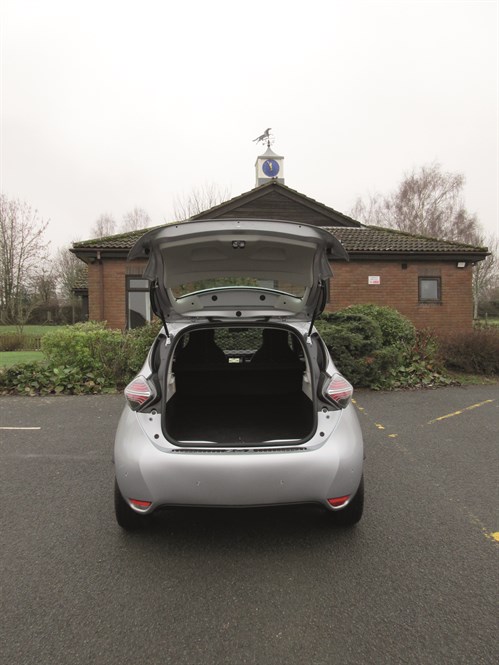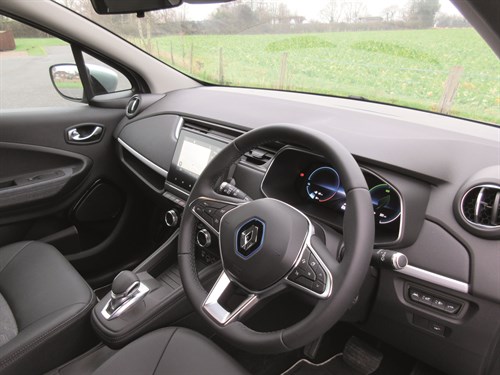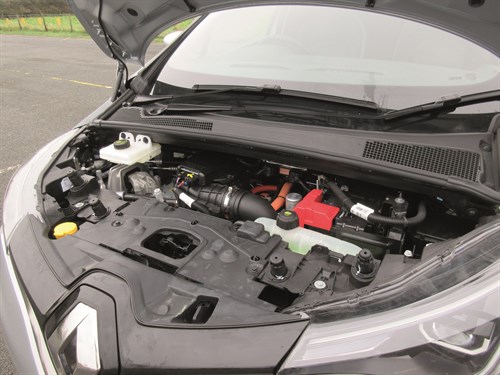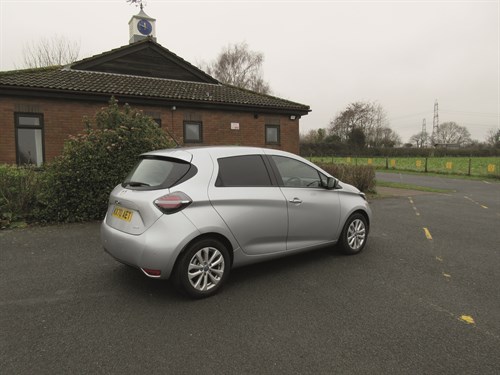Once popular as runabouts suitable for everyone from building site workers to security guards, small hatchback vans have gradually disappeared off the automotive map as customers have opted for something a bit bigger and more practical.
In recent times Ford’s Fiesta Van has had the field to itself, but it has been joined by a newcomer with a difference. While Ford’s three-door offering comes solely with a petrol engine, Renault’s five-door Zoe Van is battery-powered – and none the worse for it.
Based on the electric Zoe car, it is up for grabs with two different levels of specification: Business and Business +. Our test van was in Business + trim, but a more than respectable level of basic specification means that opting for the entry-level model is unlikely to leave you feeling short-changed.
The big argument in favour of the Zoe Van, according to Renault, is its range between recharges. You can achieve up to 245 miles (or 239 miles with the Business+ model), according to official Worldwide Harmonised Light Vehicle Test Procedure figures, the manufacturer says.
Aware that some customers still suffer from range anxiety, Renault is canny enough to quote some less-ambitious figures of its own to avoid disappointment. It suggests 150 miles in the winter, rising to 233 miles when the weather turns mild – a wise precaution.
Charge the van from a 7kW (32A/230v) wall box and you should be able to replenish the battery pack completely in 9.25 hours, the company says. If you have access to a 22kW (32A/400v) public charging point however, it adds, then you should be able to reach 100% in no more than three hours.
The Zoe Van joins an established battery-powered line-up from Renault, which includes the Kangoo Z.E and Master Z.E. Now offered as a 3.5t van, the latter model is sold through Renault Trucks dealers as well as through the car and van network.

Load bay
Access to the Zoe Van’s small 1.0m3 load area is by means of a rear hatch and hinged doors on either side.
The latter are released by somewhat flimsy-looking flaps next to what would have been the windows if the Zoe Van were a car. They have been disabled and covered with an opaque film.
Each of the side door apertures is partially obstructed by a horizontal metal bar – presumably there to stiffen what looks for all the world like a drop-in cargo box – which can make loading and unloading awkward.
A pair of covers will hopefully conceal items on the cargo bed from anyone who peers through the rear screen. The rear section of the rear-most cover rises when the hatch is opened.
The presence of a half-height bulkhead, topped off by a full-height mesh grille, should ensure that anything that slides forward under heavy braking stays out of the cab. Cargo that is likely to prove wayward can always be secured with four tie-down points.
A mixture of carpet and plastic mouldings provides plenty of protection against minor scratches and scrapes, while a rubber mat protects the load bed. Bear in mind that you are not allowed to tow a trailer.

Interior and equipment
A dial in the instrument panel tells you how much charge is left in the battery pack and how much further you can travel before it needs replenishing.
Climate control is installed and you can use the MY Renault smartphone app to switch on the air conditioning or heating before your journey so the cab is at a comfortable temperature when you get in. You can check how much charge is left in the battery as well.
Installed too are satnav, cruise control with a speed limiter, front fog lights, a heater and wash/wipe system for the rear screen, electric windows and electrically-adjustable, folding and heated exterior rear-view mirrors.
Like the door handles, their casings are finished in the same colour as the rest of the body. They do not feature a separate wide-angle section.
Two USB points are deployed in the cab, along with an aux-in socket and a 12v power point.
The Zoe Van comes with an electric parking brake controlled by a switch rather than a conventional handbrake lever between the seats.
In-cab storage facilities include a lidded, but not lockable, glove box with a shelf above it, bins in each of the doors that can clasp a 1.5-litre bottle and a tray in front of the transmission lever.
Two cupholders nestle between the seats, as does an induction charging area so you can charge your smartphone wirelessly.
Trimmed in synthetic leather, the steering wheel is height and reach-adjustable. The driver and passenger seats are both trimmed with 100% recycled upholstery.
You push a button to switch the van on so that is ready to go, but your Renault key card has to be present. If you have it about your person then the Zoe Van can be locked and unlocked hands-free. A second option is to press a button on one of the front doors to unlock the vehicle – again, with the card present – while a third is to use the card as a remote in the same way you would use a remote on a conventional key fob.
You can change the three settings using the 7in Easy Link infotainment touchscreen mounted in the centre of the dashboard, which also controls the radio and satnav. The latter can be used to locate public charging points, too. Apple CarPlay and Android Auto are included in the deal, as is Bluetooth connectivity.
An Eco button can be pressed to restrict the van’s performance and extend its range.
Turning to safety, ABS with emergency brake assist is fitted, as is electronic stability control. Hill start assist is installed as well.
Lane departure warning helps prevent drivers carelessly drifting from one lane into another. Lane keeping assist twitches the wheel in order to propel you back into your own lane should you start to wander while traffic sign recognition reminds you of the speed you should be doing.
Driver and passenger front and side airbags protect the occupants of the cab, while reversing sensors should ensure that the driver doesn’t back into anything or anyone. The headlights dip automatically at night to avoid dazzling other drivers.
Our van boasted 16in alloy wheels shod with Michelin Primacy 4-E 195/55 R16 tyres. Ventilated disc brakes are present all round and electric power steering offers a 10.56m turning circle between kerbs.
Returning to the satnav system, Business+ models come with a three-year connected package that includes live traffic information. Available too is a three-year deal that includes automatic updating of the map and multimedia system.

Powertrain
Power comes courtesy of an 80kW/108hp R110 synchronous electric motor married to a single-speed gearbox and fed by a 52kWh lithium-ion battery pack. Maximum torque is 225Nm.
The van’s charging inlet sits behind the Renault logo on the front of the vehicle and our van arrived with two battery charging cables.
One was a Type-2 cable that can be plugged into a public charging point. The other could be plugged into an ordinary domestic socket.
Whichever trim level you pick, you can opt for a Rapid Charge model – which is what we had. It means it is equipped with a 50kW DC (125A/400v) on-board charger, which can take the battery pack from a charge level of 0% to 80% in 70 minutes, says Renault. A 30-minute charge is enough for a 90-mile range boost, the manufacturer adds.
No matter what type of on-board charger is fitted, replenishing the battery from an ordinary three-pin power point in your garage still takes forever: 34.5 hours to be more precise, Renault admits. So, if you are going electric, have a wall box installed at home – a government grant to help pay for it was available in the UK at the time of writing along with support from Renault – or ensure there is a charging point at your workplace.
Driving
When the Zoe Van arrived in gloomy, cold winter weather it had covered 87 miles, had not been charged up on route, and its dashboard display stated that 67 miles remained available before we had to get out and push.
Not remotely daunted, we immediately drove from Ross-on-Wye in Herefordshire to Cheltenham in Gloucestershire and back – a round trip of 54 miles – lightly laden, and still had 21 miles left when we got back to base. The battery had 10% of its charge remaining at the end of the journey.
We drove on the Eco setting, but without maximum regeneration and with the radio, lights and heater on.
LED headlights and rear lights reduce the power draw, and both the heater and the air conditioning system make use of a heat pump to help conserve energy. Switching to Eco limits their performance, as well as the on-highway performance of the vehicle.
Subsequent trips around Herefordshire and Gloucestershire, including a trek that covered the length of the M50 from Ross-on-Wye to the M5 and back – a round trip of 44 miles – led us to conclude that the Zoe Van is most ideal for short to medium-range trips that don’t require the need to seek a charging point along the way. Renault’s claimed winter range of 150 miles could well be an under-estimate.
Trips in a Zoe Van (it won the Editor’s Choice Highly Commended accolade in the 2021 What Van? awards) could turn out to be fun.
It rides and handles well, is highly manoeuvrable, and the absence of a conventional engine means it is quiet aside from a modest amount of road noise. It accelerates strongly away from rest, but always remember that a heavy right foot will soon shorten your range.
Leaving the little van in Eco mode gives you ample performance if all you are doing is pottering around town or along rural roads. It means dual carriageway and motorway performance is restricted, however, so in those circumstances you may wish to switch
it off. If you do, just bear in mind that the charge in the battery will deplete more rapidly.
You can of course push the transmission lever over to B in order to boost the level of regeneration and put some charge back into the battery. A dial on the dashboard shows how much is going in.
Using the B setting makes particular sense if you are driving through hilly terrain. As well as recharging the battery and boosting the available range it functions in the same way that a retarder does, slowing the vehicle down when you lift your foot off the accelerator without any need to press the brake pedal.
Drive an electric van and it doesn’t take long to discover that pedestrians and cyclists use their ears as much as their eyes – and their ears are often blocked by headphones. That is a particular hazard in urban areas, but fortunately the Zoe Van can generate targeted noise at from 1mph to 19mph under the Z E Voice banner, which will hopefully alert vulnerable road users to its presence.
Pressing the auto hold button next to the electric handbrake button will stop you creeping forwards when you are sitting at the traffic lights.

Operating
Our Zoe Van demonstrator qualified for the UK government’s Plug-in Van Grant, which at £6,420 in this case reduces the basic price (excluding VAT, delivery and the first registration fee) from £26,750 to £20,330.
Even with the grant, the Zoe Van does not come cheap, but at least it is cheap to run. Renault suggests that it will cost £0.03 per mile to fuel it in the summer rising to a still-modest £0.05 per mile in the winter.
A five-year/100,000-mile warranty is provided, with no mileage limit in the first two years. Three years’ roadside assistance forms part of the deal, the paintwork warranty runs for three years and the anti-corrosion warranty for 12 years.
The battery pack is warranted for eight years/100,000 miles, and service intervals are set at 12 months/18,000 miles.
Our demonstrator was finished in optional metallic paint. It seemed a pity there were no side rubbing strips to help protect it from harm.
A Category 1 alarm is included in the specification and all the doors lock automatically when the van is in motion.
A tyre inflator and sealer is provided rather than a spare wheel and is stowed under the cargo floor along with a medical kit. We’d much rather have a proper spare, even though it adds weight. Nevertheless, it is reassuring to see that a tyre pressure monitoring system is present.
Renault Zoe Van Business+ R110 Z.E 50 Rapid Charge
Price (ex VAT) £27,625**
Price range (ex VAT) £25,500-£27,625**
Gross payload 368kg
Load volume 1.0m3
Load length 1,205mm
Load width (min/max) 950mm/1,110mm
Load bay height 850mm
Loading height 711mm
Rear door aperture 965mm x 825mm
Side door aperture 800mm x 1,016mm
Gross vehicle weight 1,988kg
Braked trailer towing weight N/A
Residual value 30.2%*
Cost per mile 36.2p
Engine size/power 80kW (108hp) electric motor
Torque 225Nm
Gearbox 1sp
Range 239mls (WLTP)
Battery 52kWh
Warranty 5yrs/100,000mls
Service intervals 1yr/18,000mls
Insurance group 31E
Price as tested £28,091**
* after 48 months/20,000mls p.a – source – KWIKcarcost
** Before Plug-in van grant
Options
Metallic paint £466
Rivals
Nissan e-NV200
Price (ex VAT) £26,250-£31,350**
Load volume 4.2m3
Gross payload 631-705kg
Engines 80kW
Verdict: When we road-tested this model back in 2019, we described it as the most convincing electric van we had encountered to date. New rivals have come along since, but with a decent-sized cargo area and a claimed range of up to 187 miles, the e-NV200 remains in contention.
Peugeot e-Expert
Price (ex VAT) £32,965-£42,380**
Load volume 3.2-6.1m3
Gross payload 1,000-1,004kg
Engines 100kW
Verdict: The smallest electric light commercial in the Peugeot line-up until the new e-Partner arrives in November, the e-Expert is one of the most impressive medium-sized zero-emission panel vans on sale in the UK in terms of both range and carrying capacity. The same model is up for grabs as the Citroen e-Dispatch and the Vauxhall Vivaro-e.
Renault Kangoo Van Z.E
Price (ex VAT) £25,500-£28,900**
Load volume 1.3-4.0m3
Gross payload 605-640kg
Engines 44kW
Verdict: An established and popular player in the electric van sector, the Kangoo Van Z.E needs an upgrade to ensure it stays competitive. More power is a must given that the electric motor packs significantly less punch than the one fitted to the smaller Zoe Van. A new model is imminent, which is likely to pack more wallop. Note that the Kangoo Van Z.E is no more expensive than the Zoe Van, but it can carry more.
The Final Verdict
Design 7/10 – A cleverly thought out vehicle but the cargo area is a bit of an afterthought.
Cabin 8/10 – Stylish working environment with plenty of useful touches.
Ride 8/10 – Better than most small vans and seldom upset by the UK’s motorway surfaces.
Refinement 9/10 – Quiet, bar a small amount of road noise, and well put together.
Load area 6/10 – Small and not that easy to access, but it is of course a compact van.
Handling/performance 7/10 – Both are top-notch, but the van’s range will suffer if you have a heavy right foot.
Engine/transmission 8/10 – Well matched, but make sure you shift the transmission lever across to the maximum regeneration setting as frequently as possible.
Standard equipment 8/10 – No shortage of kit, and the 50kW DC onboard charger could prove invaluable.
Operating costs 8/10 – Day-to-day running expenses will certainly not break the bank.
What Van? subjective rating 8/10 – An impressive little van that makes for an ideal zero-emission local runabout.
Overall Rating: 77/100





